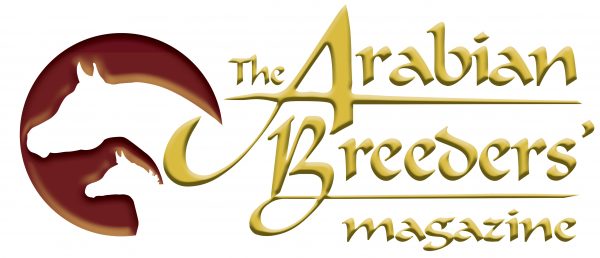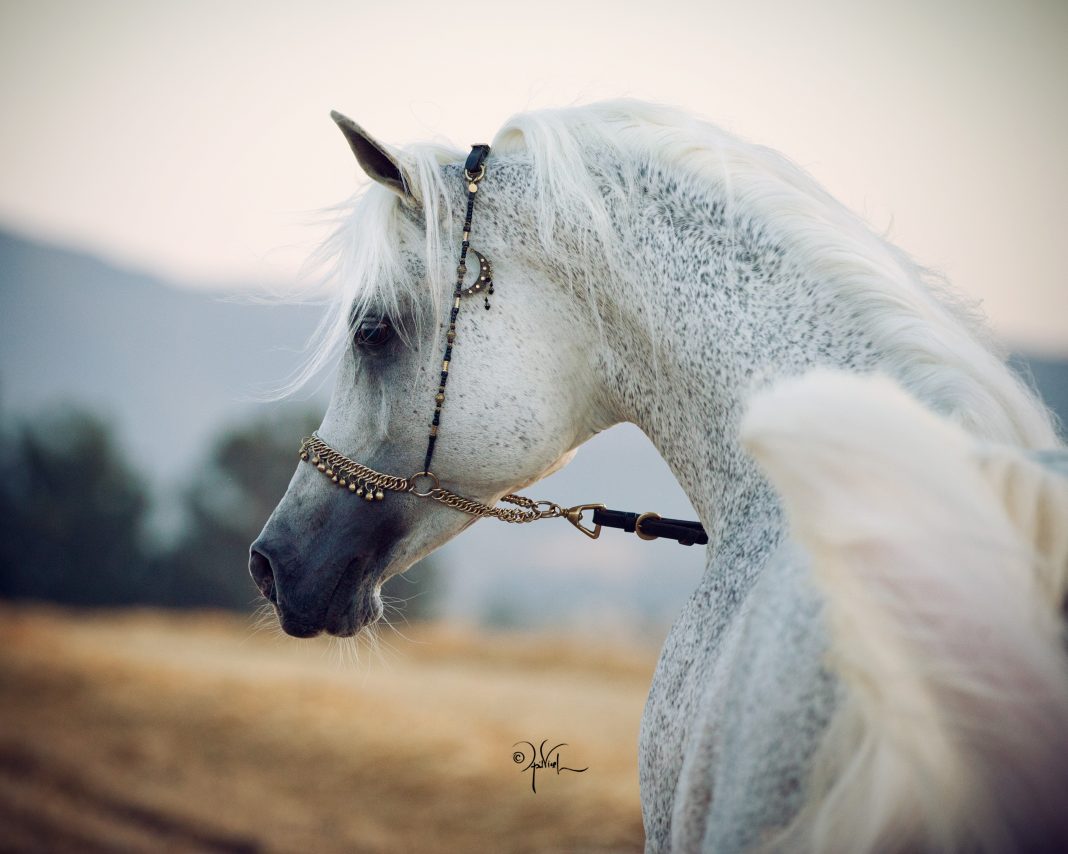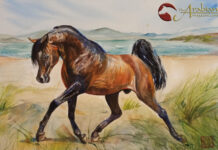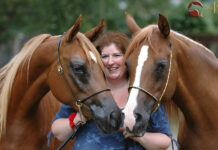The Breeders Interview – Christie Metz, Silver Maple Farm
In every edition of The Arabian Breeders’ Magazine, we speak to a selection of breeders from around the world about their experiences and successes with their breeding programme. We are delighted to share some of these incredibly insightful features online.
The Arabian Breeders’ Magazine (TABM): Please share with our readers a short background of your farm.
Christie Metz, Silver Maple Farm, USA: Silver Maple Farm became a business in 1991, in Sioux City, Iowa in the Midwestern region of the United States. This area of the country is described as the Heartland of America and we are both very proud to have our roots in the Midwest.
Henry and I began to trail ride Arabians in 1989. Through our wonderful mentor, Judy Jones of Atallah Arabian Farm, we became intrigued with breeding Arabians. Judy had several breeding programmes at her farm with many Arabian bloodlines. It was Judy that taught me about being a small, quality focused breeder, how to enjoy the horses and know them personally. She encouraged Henry and me to envision our dream horse, and she explained the need for a dedication of purpose. In part, you must be an artist, scientist, and understand equine management.
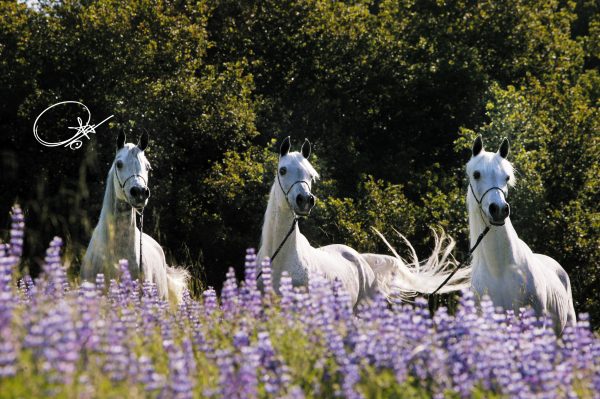
Three generations of the same mare family (l-r)COLON Shaboura (PVA kariim x Sahbine) , Sahbine (Ruminaja Ali x Glorietasayonaara) and Glorietasayonaara (Ansata Abu Nazeer x Glorieta Shahlima). Credit Gigi Grasso.
TABM: What have been the bloodlines that you have focused on, and why did you choose them? Has this focus changed over the years?
Christie: We chose the straight Egyptian and Egyptian-sired Arabian bloodlines to concentrate on for our breeding programme. Besides them being visually appealing to us, the smaller gene pool to select from seemed, at the time, to make breeding choices easier..! Henry and I loved to use the straight Egyptians with the Spanish bloodlines, some Polish and Russian lines too, and we did that from 1991 until 2006. At that time, Henry and I decided it was important to concentrate on the straight Egyptian horses since they are a small percentage, 4%, worldwide of the overall Arabian community. Straight Egyptians are renowned as a resource for type and refinement for all Arabians. My eye always found those Arabians with a high percentage of straight Egyptian bloodlines in their pedigrees. They seem to have a distinct look that carries the following elements: ethereal with a refinement of proportion, this gives them a heightened elegance; and there is an extra chiselling of the bone in their faces combined with a dryness of sinew and tendon on their legs. Everything about them is very sculptural in shape. They are rounded horses, not angular, and as a rider, I appreciate this strength in style. Predominately, the straight Egyptian horses at Atallah were a combination of Ansata bloodlines and Gleannloch Farms. These farms were the first primary importers of straight Egyptian Arabians to the USA along with the Griffiths of Imperial, St. Clair, Bentwood, and other farms. The stallions, Ansata Ibn Halima (Nazeer x Halima) and Gleannloch’s Morafic (Nazeer x Mabrouka) worked beautifully with each other’s daughters, creating a golden cross or breeding nick.
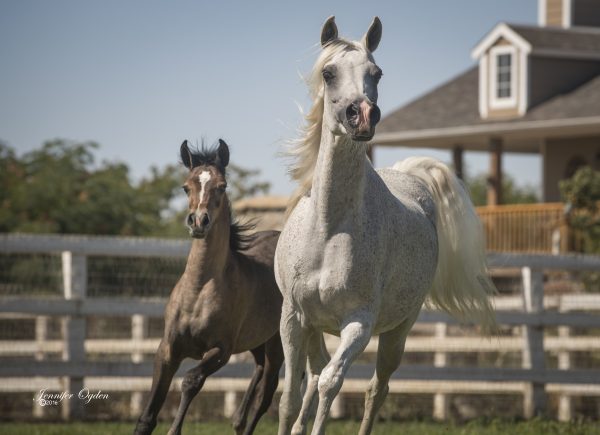
Bint Bint Sayo (Ali Saroukh x Samura) with her 2016 filly by Majestic Noble SMF (Marquis I x Nagda). Credit Jennifer Oyden.
Judy taught me over a period of several years about Arabians while riding our trail horses together, almost daily. She gave me a historical perspective along with information on the science of breeding and equine management. Of course, I passed the information on to Henry, and he was equally fascinated. Another very important piece of advice she gave us was to visit as many breeding farms as possible, to see all kinds of breeding programmes. We listened, travelling all over the USA. Later, we added the Middle East, Egypt and a few European countries. Nothing replaces seeing the horses in person – touching, observing, evaluating, and seeing multiple generations at one farm.
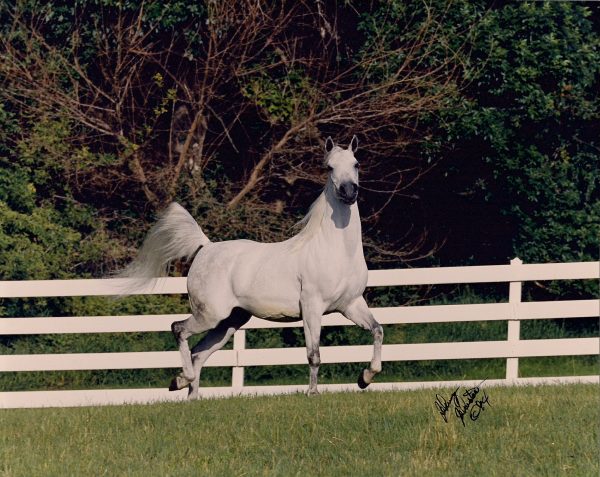
Glorietasayonaara (Ansata Abu Nazeer x Glorieta Shahlima). Credit Johnny Johnston.
TABM: What were your breeding goals when you first started? Have they changed over the years?
Christie: Initially, our goals were quite simple: breed two mares a year, sell the foals by showing them at an ‘A’ show or two, regionally, the Egyptian Event, and possibly the Nationals to promote the horses. Then we evolved into creating families with our mares, keeping a daughter, or son, sometimes both, and adding to the generations. We always have the goal of improving the horses of Silver Maple Farm.
Now, we have four Dahmah mare families and two Hadbah families of mares. We prefer an upright neck with good length and shape, with a clean throatlatch, big dark eyes, well set, finely turned ears and of course, correct conformation. We prefer our horses to be rounder, three equal circles from the tip of the tail to the head, as Judith Forbis discusses in her book The Classic Arabian Horse. Temperament is important to both of us. We want our horses to be a pleasure to handle and be willing to work. Movement is important to us as well.
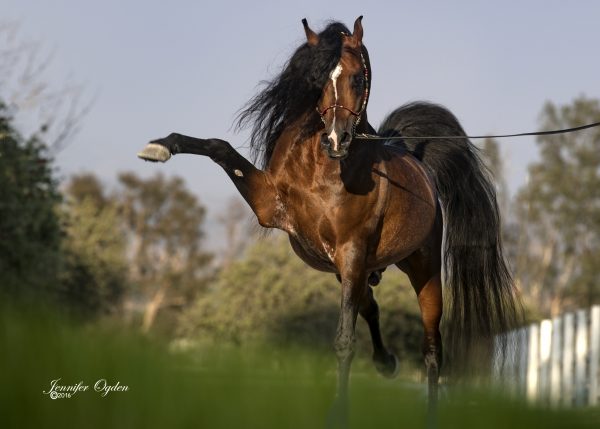
Sayo Sahran SMF (Makhnificent KA x Bint Bint Sayo). Credit Jennifer Oyden.
We have deliberately chosen to concentrate on mare lines, believing that the mare contributes more to the overall phenotype than the stallion. We learned over the years to select mares that produced colts with stallion quality as well as fillies. It is essential for small breeders to produce more fillies because to produce a great stallion, is much more difficult. Fortunately, three of our mare families produce mostly females. Over the years, we have also learned to observe the fertility, general health and mothering abilities of those mares. Observation is one of the best tools a breeder has to make improvements.
However, the stallions we use now are all from these same mare families too, even when we use another farm’s stallion and keep a son. It is our Ali Saroukh (Ruminaja Ali x Glorietasayonaara) daughters who provided a jump in quality to the next level in our programme. Stallions will often produce better daughters than sons and to date this is true of Ali Saroukh. However, Majestic Noble SMF (Marquis I x Nagda) and Symbolic SMF (Majestic Noble SMF x Shaboura) produce both good sons and daughters, and I believe this has been passed down the mare lines, especially those of Bint Magidaa (Khofo x Magidaa) and Glorietasayonaara. I am hopeful their daughters will be the same pattern of production, giving both male and females of superior quality. When we do use an outside stallion, we always look to the dams within the pedigree. Of the four main straight Egyptian male lines that came to the USA via their sons, we have Sameh (El Moez x Sameera) and Nazeer (Mansour x Bint Samiha) sire lines. At Silver Maple, our homebred sires are Ali Saroukh, Majestic Noble SMF, Symbolic SMF, Jasoor SMF (Simeon Shai x Jade Lotus SMF), Sayo Sahran SMF (Makhnificent KA x Bint Bint Sayo), and Hajji Bekeer SMF (Majestic Noble SMF x Haalani SMF). We also own a Makhnificent KA (Makhsous x Star Bint Hafiza) son, Khaled KA, out of Noble Sefra (Ruminaja Bahjat x Talyla) who relates to our Dance Diva (Raquin RA x Antigua Dance) family of mares on his tail-female side.
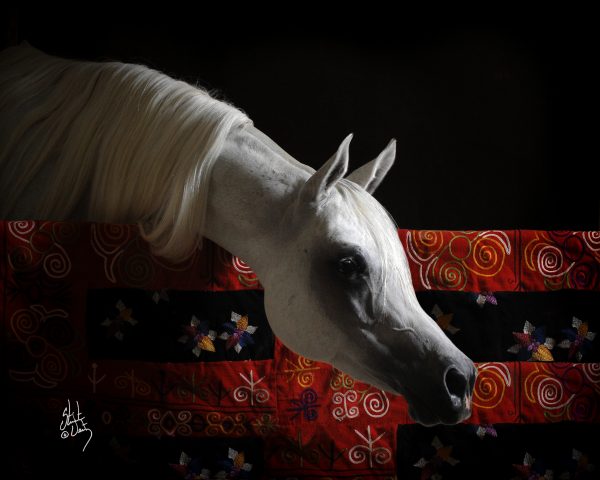
Shaboura (PVA kariim x Sahbine). Credit Stuart Vesty.
TABM: Please share key moments that stand out in the early stages of your breeding programme?
Christie: Two mare purchases are prominent benchmarks for Silver Maple because they set the bar for our quality of mares in the programme.
It started with purchasing our first straight Egyptian Arabian mare, Glorietasayonaara (Ansata Abu Nazeer x Glorieta Shahlima). She became the foundation mare at Silver Maple. In 2017, the fifth generation of her family will be born at our farm when Sheikha Sara SMF (Symbolic SMF x Bint Bint Sayo) has her first foal, by Ali Saroukh.
Glorietasayonaara, or ‘Sayo’, ‘Sigh-O’, as we called her, was an amazing mare regardless of bloodline. Bred by Mike and Kiki Case of Glorieta Ranch, Judy Jones purchased her at a dispersal auction. It took me two years to convince Judy to sell us this mare. Sayo made my heart pound and gave me goosebumps; her eyes were so expressive, and she was the perfect blend of fire with sweetness. This trait passes to each generation and always makes my heart sing.
The second mare is Shaia+ (Simeon Shai x Bint Zlabiya), an Egyptian-sired mare with a tail female Spanish line, and she was purchased in 1995. I first saw her in 1991 as a five-month-old filly on a Simeon Shai (Raadin Royal Star x Simeon Safanad) stallion promotional video in 1991. It took almost four years to talk Bruce Clark and Gerry Alexander of BruMarba Arabians into selling her to us. She was five when we bought her, and she is 26 years old now. Shaia was Canadian Reserve National Champion Halter Breeding Mare in 1995 and Egyptian Event Supreme Champion Mare the same year. At the US Nationals that year, she was Top Ten Mare and the crowd favourite; they gave her a standing ovation. This crowd adulation has only happened once for a Top Ten Mare since that year and years later, one other time, for a younger horse. Shaia brought Silver Maple Farm to National attention. Judy told me to think of shows this way: “If you are still happy with the horse you are taking home, then it is all good; doesn’t matter what she/he did or didn’t win.”
Most breeders that I am aware of have an ‘eye’ for beauty and an instinct for the next steps in a breeding programme. Sheila Varian had this gift, as did Sigi Siller and her daughter Janina does as well. Marieta Salas, Lenita Perroy, Jenni and Paul Ogden, Judith Forbis, Marion Richmond, Dr Hans Nagel, Jean, Becky and Nancy Rogers, Judy Jones, Judy Guess, Omar Sakr and Dr Nasr Marei… There are countless other dedicated breeders that I am forgetting to mention so please forgive me. There is no breeding formula that replaces this gift, or innate ability. An eye may be developed to a degree but in my opinion, only the most talented have this gift.
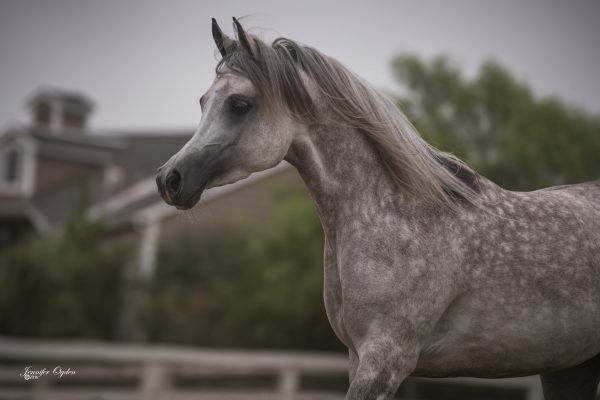
Sheikha Sara SMF (Symoblic SMF x Bint Bint Sayo). Credit Jennifer Oyden.
TABM: When was it that you realised that you were a successful breeder? And what, in your opinion, defines a ‘breeder’?
Christie: When we began to see our personal vision of the ideal Arabian realised in the foals produced, by the stallions we had bred and out of the mares that we had bred. There is a consistency within our herd, a certain look. It is exciting when you see each generation shows improvement. The details we intended to add are happening, and that is satisfying.
What defines a breeder? Well, I think Henry sums this up perfectly: “When the intangible meets the tangible. “In other words, the intangible is the vision a breeder has in their mind’s eye, for their ideal Arabian, and they make it happen and the result of their ‘ideal’ is visually tangible.
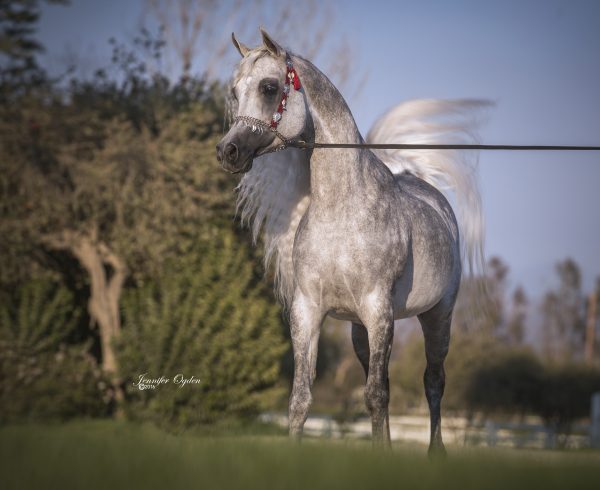
Sidon SMF (Ali Sharoukh x Shaboura). Credit Jennifer Oyden.
TABM: As a breeder, how do you feel about the showing world? Do you think that changes are needed to celebrate breeders more?
Christie: Some of the performance venues are a real test of athleticism but showing halter in-hand is another story. The in-hand style of showing is outdated – it is at least fifty years old, without much updating, and it is very artificial. The style of display seems out of step with our world today when people question the validity of everything.
In my opinion, the worst part is that this manner of showing does not exhibit the Arabian horse’s sense of pride and joy, and it fails miserably in displaying those traits. To make mares and foals emulate a stallion looking intently at a mare is just unnatural and awkward. What does this say to someone new when first seeing Arabians strike these exaggerated poses? It tells them nothing about the Arabian horse.
Henry and I do not use the show-ring to see what is happening in breeding except for a few bloodlines. For that, we go to farms and see the multiple generations of the horses there. This tells us much more. It also gives us a sense of how our horses compare in quality. We do show a tiny bit, but not very often.
Over the years, the show-ring and, in particular the halter arena, demonstrates a fickleness; there are trends of styles that become in vogue. This is human nature. However, sometimes these trends are just not beneficial to the Arabian horse over the long term. Anytime a trait is exaggerated, and the hallmarks of the breed ignored, it is detrimental to the Arabian. These are short term breeding decisions made with long-term consequences. It does not mean I think poorly of others who wish to participate, but a breeder needs to have long-term goals in mind.
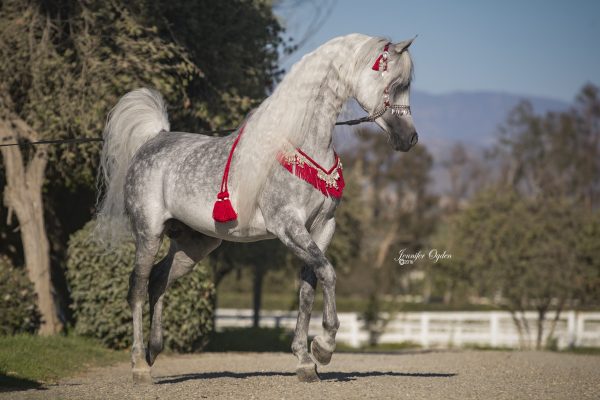
Sidon SMF (Ali Sharoukh x Shaboura). Credit Jennifer Oyden.
TABM: Do you think that breeders are a dying breed, pardon the pun?
Christie: Yes. The thoughtful and dedicated breeder who is willing to persevere in the face of any hardship, and serve as a mentor for the next generation of breeders, is not admired or cultivated for a variety of reasons nowadays. There is no motivation for them to breed and they are not respected, even as judges, but seen as a means to an end. There are major external influences in today’s world. The costs of breeding, land, feed, and staff are ever climbing, so this causes attrition as well. The competition for disposable entertainment income is at issue, too, as there is so much to choose from now.
Worse, there seems to be an air of impersonal commercialisation in the horses overall. It is lacking the stamp of individuals creating a variety of styles and interest. Almost as if it has become big business for just a few and with less gracefulness. That is life, in general, these days, conducted online and not interactive, or in person. Our world is a very different place in these times, and inevitably, individuals and horses, through their humans, are affected.
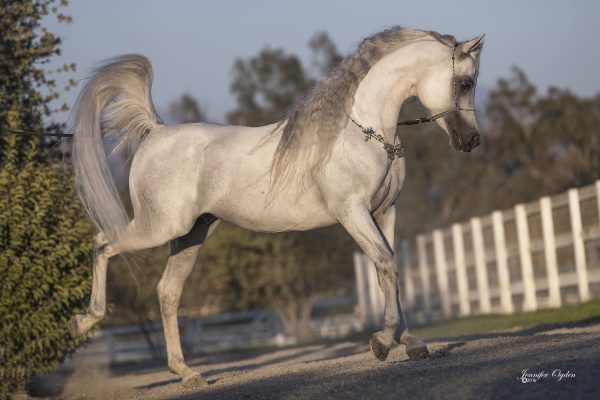
Symbolic SMF (Majestic Noble SMF x Shaboura). Credit Jennifer Oyden.
TABM: Do you think that breeders and dedicated breeding programmes still have a place in the world today?
Christie: There are cyclical periods in the world of finance, culture, governments that affect the breeding of horses too. I hope that commitment to breeding does not become totally passé, but I have no way to predict this.
Concerning our horses, I think it would be quite sad for the Arabian horse if smaller or medium sized, dedicated breeders do not continue to contribute overall to the breed. Moreover, I would miss meeting some of the characters that come with small and medium-sized breeding operations. Friendships with other breeders are often the encouragement needed to continue with, and the spark for a new approach in breeding. My most enjoyable times have been spent with other breeders at their farms, listening to them discuss their bloodlines. Seeing the joy they have and the relationships with their horses. Horses may be hard on the ego and billfold, but they are definitely good for the soul.
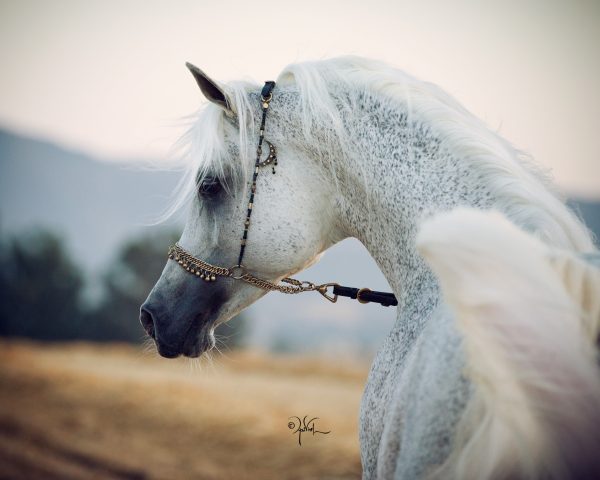
Ali Saroukh (Ruminaja Ali x Glorietasayonaara). Credit April Visel.
TABM: Over the years, what have been your key successes, perhaps the ones that define your farm?
Christie: Being honest, transparent with people, and communicating exactly what our horses represent. Silver Maple horses celebrate a classic, timeless type and quality. They transcend stylised trends.
TABM: And finally, what is next for you and your breeding programme?
Christie: Passing forward the love of this breed through writing, speaking, and holding workshops. Encouraging hands-on involvement with Arabians and, of course, creating a legacy through our Silver Maple Farm horses. Enjoying the horses themselves, even riding again. Possibly, someday, fifty years from now, approximately 12 generations away, someone will say ‘did you know, there was a couple from the USA; they had a farm named Silver Maple, and they bred magnificent horses and our horses trace to them!”
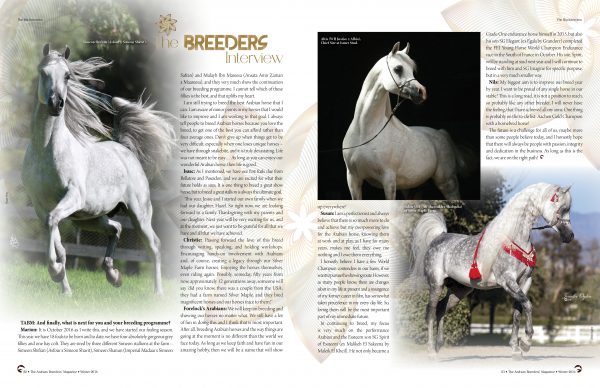
First printed in The Arabian Breeders’ Magazine Volume I Issue II December 2016. To enjoy further content such as this, please visit The Arabian Magazine Shop.
